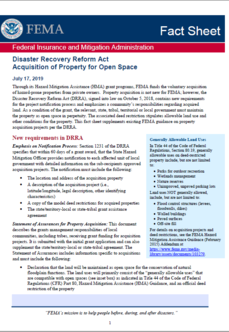The application period for
FEMA’s Fiscal Year 2019 Hazard Mitigation Assistance (HMA) grants under the
Flood Mitigation Assistance (FMA) and Pre-Disaster Mitigation (PDM)
programs is now open. Eligible applicants must apply for funding through
the FEMA Mitigation eGrants system on the FEMA Grants Portal. All applications
must be submitted no later than 3 p.m. Eastern Standard Time (EST) on
January 31, 2020.
For FY19, a total of $410
million in funding is available through HMA’s two competitive grant
programs, FMA and PDM.
- For the FMA program, FEMA’s
predetermined funding priorities include flood mitigation planning and
efforts for repetitive as well as severe repetitive loss properties.
In this application cycle, $160 million in funds are available. View
the FY19 FMA Notice of Funding Opportunity (NOFO) and Fact Sheet for
more information: www.fema.gov/flood-mitigation-assistance-grant-program.
- The PDM program is designed
to implement a sustained pre-disaster natural hazard mitigation
program with the goal of reducing overall risk to the population and
structures from future hazard events. For FY19, FEMA has set aside $20
million of the $250 million in PDM funding for federally-recognized
tribes. View the FY19 PDM NOFO and Fact Sheet for more information: www.fema.gov/pre-disaster-mitigation-grant-program.
FEMA’s two competitive
mitigation grant programs provide states, tribes, and territories funding
for eligible mitigation activities to strengthen our nation’s ability to
build a culture of preparedness by reducing disaster losses and protecting
life and property from future disaster damages.
The Fiscal Year 2019 hazard
mitigation funding cycle represents a critical transition year for
pre-disaster mitigation grants. One of the most substantive provisions of
the Disaster Recovery Reform Act of 2018 is Section 1234, which authorizes
FEMA to develop a new pre-disaster mitigation program that is funded by a 6
percent set-aside from federal disaster assistance for each major disaster
declaration. This new program, Building Resilient Infrastructure and
Communities (BRIC), will allow FEMA to support states and
communities to undertake new and innovative infrastructure
projects that reduce the risks they face from disasters. FEMA is already
using the BRIC funding mechanism to advance its objective of increasing the
nation’s resilience by making $250 million available for the FY19 PDM
Program.
Throughout October, FEMA will
continue to offer a series of webinars on the FY 2019 PDM and FMA
grant programs. Upcoming sessions are listed below. You can also view the
complete webinar schedule here.
eGrants for Beginners
Join this webinar to learn how
to use Mitigation eGrants, the system
that FEMA uses to accept and process all grant applications. This
webinar will be offered twice and prospective FY19 applicants may
attend either session. The webinar will cover how to access the system,
where to go for help, and include a question and answer period. The webinar
is primarily intended for subapplicants and new users.
- Wednesday, October 16, 2019
at 5 p.m. Eastern Time
- Monday, October 21, 2019
at 9 a.m. Eastern Time
Avoiding Application
Pitfalls
FEMA will offer a webinar on
common PDM grant application errors and how to avoid them. This
webinar will be offered twice and applicants may attend either
session.
- Tuesday, October 8, 2019 at
2 p.m. Eastern Time
- Tuesday, October 15,
2019 at 2 p.m. Eastern Time
FEMA and its partners are
working on the development and implementation of BRIC.
A series of four webinars held
in June 2019 provided an overview as the BRIC program is being developed and
facilitated an open conversation with stakeholders through the chat
platform webinar tool. Participants were encouraged to share their thoughts
and ideas in real-time during these webinars or had the option to provide
comments on a dedicated idea sharing platform known as IdeaScale.
FEMA continues to monitor a
dedicated email box for any comments or suggestions about the development
of BRIC at buildbric@fema.dhs.gov.
 Following the devastation of Hurricane Sandy in 2012, the
Government Accountability Office (GAO) identified a need for a
coordinated, federal and national investment strategy for mitigation that
reduces the nation’s exposure to future losses from disasters. In
response, the Mitigation Framework Leadership Group (MitFLG) produced a National
Mitigation Investment Strategy. Following the devastation of Hurricane Sandy in 2012, the
Government Accountability Office (GAO) identified a need for a
coordinated, federal and national investment strategy for mitigation that
reduces the nation’s exposure to future losses from disasters. In
response, the Mitigation Framework Leadership Group (MitFLG) produced a National
Mitigation Investment Strategy.
The Investment Strategy
establishes a vision to save lives and money nationwide by investing in
mitigation resources and activities such as:
- Building to
disaster-resistant codes or standards
- Collecting and sharing
data that identifies disaster risk
- Aligning funding
requirements and incentives to make mitigation doable
- Identifying weaknesses
that increase disaster risk
- Sharing expertise and
advice on how to mitigate
The Investment Strategy’s
national vision is for the whole community, which includes individuals,
families, communities, the private and nonprofit sectors, faith-based
organizations, and state, local, tribal, territorial, and federal
governments.
|
|
|
|
Through its Hazard Mitigation
Assistance (HMA) grant programs, FEMA funds the voluntary acquisition of
hazard-prone properties from private owners. Property acquisition is not
new for FEMA; however, DRRA Section 1231 contains new requirements for
the project notification process and emphasizes a community’s
responsibilities regarding acquired land.
The newly released DRRA
Section 1231 Fact Sheet outlines these new requirements for
state, tribal, territorial and local governments and supplements existing
FEMA guidance on property acquisition projects per the DRRA.
FEMA also released a policy
clarification on the Eligibility
of Hazard Mitigation Assistance Applications with Pre-Award Demolitions.
This policy clarifies that when private individuals have demolished
damaged structures using private funds or other non-federal funds prior
to application for HMA funding, the properties will now be eligible for
inclusion in HMA project applications if the demolition is not connected
to the project. The demolition costs cannot be included in the project
application.
|
|










